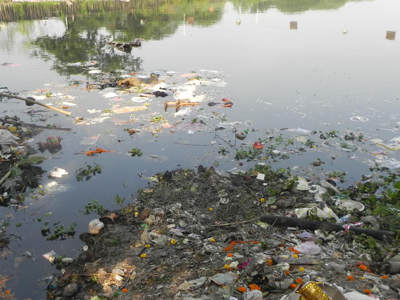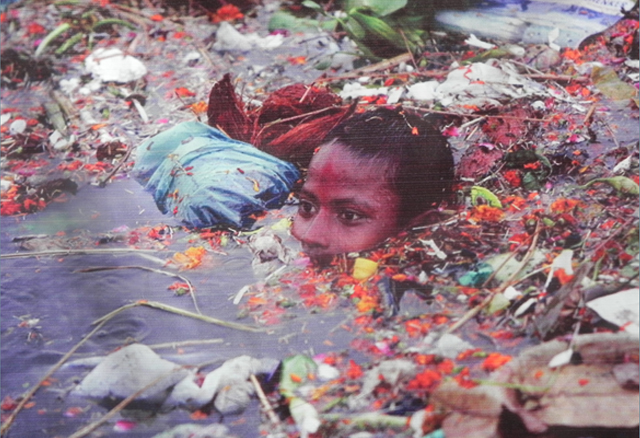Hindu Idol Immersion: Practice & Pollution
Hindus, who worship their Gods and Goddesses in the form of clay idols, practice idol immersion as an important aspect of their culture. The ceremony marks the farewell of the deities to their abodes and is accompanied by the belief that, after being worshipped, the idols must be immersed in water because only Mother Earth can bear their power and energy. This practice is seen in the worship of almost all Hindu deities like Durga, Ganesha, Saraswati and others. Historically, idols were mostly made from clay and treated at the time of the rituals with turmeric and other herbal products to avoid pollution of the water bodies. But with the passage of time, non-clay materials and even metals have come into use in idol preparation. Consequently, their immersions are leading to significant water pollution throughout the country and have become a serious health concern for humans, local aquatic ecology and the environment.
Durga Puja (worship of Goddess Durga) is one of the largest celebrated festivals in West Bengal and other adjoining states in Eastern India. It marks the welcome and worship of Goddess Durga for nine long days with the 10th day heralding the return of the Goddess in the form of idol immersion. The ritual begins with Mahalaya, which signifies the victory of good over evil and is celebrated by listening to hymns from the holy Hindu scripture Devi Mahatmyam. On the day of immersion, all idols, along with their apparel, are immersed in water mostly in the sacred river Ganges. On the other hand, Ganesha Utsav (Festival of Lord Ganesha, popularly known as “Elephant God” in western culture) is celebrated with pomp and grandeur for 10 to 12 days in the Western Indian state of Maharashtra. On the festival’s last day, all idols are taken via a procession to their places of immersion, accompanied by thousands of devotees praying to the Lord to take away their misfortunes. The immersion ceremony is broadcast live on every news channel in the country.

Photo Courtesy Saikat Basu | Idol immersion at Howrah, West Bengal, India
The major contamination source comes from the idol immersion of Lord Ganesha during the Ganesha Festival and Goddess Durga during the Navaratri. Recent studies conducted across different states in India have demonstrated rapid deterioration of water quality in lakes, streams and riverine water bodies as a result of this immersion practice. The high nitrate and phosphate levels in these lakes are leading to eutrophication. The post-immersion period has also noted a rise in the Bio-Chemical Oxygen Demands in the water bodies, as well as oil and grease levels, posing a serious threat to human and aquatic life. Metals and other toxic chemicals used in idol making carry significant risks of deteriorating human health if these polluted waters are used for drinking and other household purposes. As per World Health Organization rules, water collected from a source can be qualified as “wholesome water,” i.e. water suitable for human consumption, only if it conforms to the following criteria:
- It should be free from pathogenic organisms;
- It should be free from harmful chemical substances;
- It should have a pleasant taste;
- It should be suitable for domestic use.
But water samples tested from these polluted water bodies, which are major sites for idol immersion across the country, have shown an increase in inorganic constituents like nitrates, phosphates and toxic metals, such as lead and chromium, along with increased microbial activity. Nitrate and orthophosphate levels rise due to addition of organic constituents to the water body at the time of idol immersion. Among heavy metals, lead and chromium come from paints used to color idols.

Photo Courtesy Saikat Basu | Dumping of religious waste artifacts in a water body.
Excess intake of lead beyond permissible limits can lead to anemia, facial pallor, colic and constipation, lead palsy, encephalopathy, hypertensive arterial diseases, interstitial nephritis, amenorrhea, dysmenorrhea and even fetal malformations due to placental transfer of lead in pregnant women. Lead undergoes bio-accumulation in water bodies and, thus, results in high levels of toxicity in people chronically exposed to the metal. Excess chromium, on the other hand, can cause hemolytic anemia, renal and hepatic failures, dermatitis and even carcinogenesis. The threat is not only restricted to human life but also to a broad range of species either inhabiting or dependent upon these water bodies for their sustenance. This includes large numbers of invertebrates and vertebrates like fish, reptiles, birds and mammals. Idol immersion also results in elevated water body temperatures leading to enhanced chemical and biological reactions, reduced solubility of gases, associated pH alteration and total hardness of water. The high chemical content in these water bodies leads to eutrophication, which reduces light penetrability to the depth. As a result, plants at the bottom of lakes are deprived of raw material for photosynthesis; hence, the food source for aquatic animals is seriously compromised. This can negatively impact local biodiversity, with the food web becoming prone to break down.
When idols are made from materials like polystyrene, their immersion in the lakes and other water bodies brings further unwelcome environmental hazards. Because polystyrene materials are non-biodegradable, they float on the water surface clogging pipes and other outlets. When such materials are picked up by scavengers and burned in the open, the fumes increase concentration of harmful irritant gases in the atmosphere. Inhalation of such gases predispose to development of chronic obstructive pulmonary disorders among people. A serious health threat also exists for the scavengers, who are, in most cases, children from the lower economic strata of society.

Photo Courtesy Saikat Basu | A child collecting materials from dumped idol immersion.
What can be done to control this menace? Is it possible to stop such religious rituals? Of course not. But, it is possible to modify a few things in order to control the pollution to the safest limit possible. Idol makers must revert back to the original tradition of making clay idols and avoid unnecessary use of harmful chemicals so post-immersion periods do not pose a significant water pollution threat. Attempts are ongoing to encourage worshippers to immerse idols in special temporary water tanks built by city and municipal authorities. However, popularization of such scientific practices is still a long way off.
In a country like India where people are reluctant to abide by rules, strict legal enforcement is required with penalization of offenders to curb the nuisance. Also, mass media and public education will play a major role in raising awareness as concerned people work to protect Mother Nature without hurting people’s religious sentiments. In this way, the purpose of divine worship will then be truly accomplished when everyone learns to conserve the precious possessions of Nature that have been handed down through generations. Such valuable natural treasures and resources cannot be destroyed in the name of rituals and legacy.




























